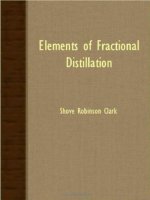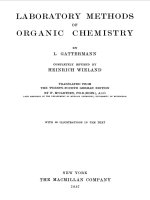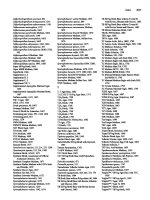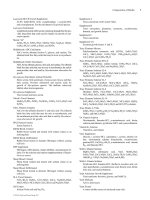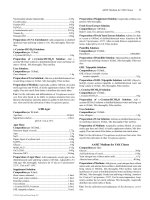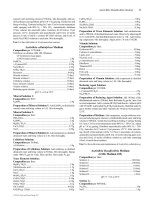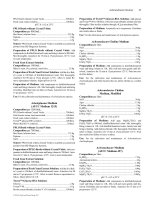methods of organic synthesis fourth edition
Bạn đang xem bản rút gọn của tài liệu. Xem và tải ngay bản đầy đủ của tài liệu tại đây (6.12 MB, 507 trang )
This page intentionally left blank
M O D E R N M ET HODS OF OR GANI C S YNTHES I S
The fourth edition of this well-known textbook discusses the key methods used in
organic synthesis, showing the value and scope of these methods and how they are
used in the synthesis of complex molecules. All the text from the third edition has
been revised, to produce a modern account of traditional methods and an up-to-date
description of recent advancements in synthetic chemistry. The textbook maintains
a traditional and logical approach in detailing carbon–carbon bond formations,
followed by a new chapter on the functionalization of alkenes and concluding with
oxidation and reduction reactions. Reference style has been improved to include
footnotes, allowing easy and rapid access to the primary literature. In addition, a
selection of problems has been added at the end of each chapter, with answers
at the end of the book. The book will be of significant interest to chemistry and
biochemistry students at advanced undergraduate and graduate level, as well as
to researchers in academia and industry who wish to familiarize themselves with
modern synthetic methods.
Bi ll Carruth e rs was born in Glasgow. He won a bursary to Glasgow University, where he graduated with a first-class honours degree in 1946 and a Ph.D.
in 1949. He moved to Exeter in 1956, working first for the Medical Research
Council and then, from 1968, as a lecturer then senior lecturer at the Department
of Chemistry in the University of Exeter. He died in April 1990, just a few months
before he was due to retire.
Iain Coldham was born in Sandbach, Cheshire. He graduated from the University of Cambridge with a first-class honours degree in 1986 and a Ph.D. in 1989.
After postdoctoral studies at the University of Texas, Austin, he moved in 1991 to
the University of Exeter as a lecturer then senior lecturer. He is currently Reader
at the Department of Chemistry in the University of Sheffield and specializes in
organic synthesis.
MO DE RN M E THODS OF
O R G ANI C S YNT HE SIS
W. CARRUTHERS
Formerly of the University of Exeter
IAIN COLDHAM
University of Sheffield
Cambridge, New York, Melbourne, Madrid, Cape Town, Singapore, São Paulo
Cambridge University Press
The Edinburgh Building, Cambridge , UK
Published in the United States of America by Cambridge University Press, New York
www.cambridge.org
Information on this title: www.cambridge.org/9780521770972
© First, second and third editions Cambridge University Press 1971, 1978, 1987
fourth edition W. Carruthers and I. Coldham 2004
This publication is in copyright. Subject to statutory exception and to the provision of
relevant collective licensing agreements, no reproduction of any part may take place
without the written permission of Cambridge University Press.
First published in print format 2004
-
-
---- eBook (EBL)
--- eBook (EBL)
-
-
---- hardback
--- hardback
-
-
---- paperback
--- paperback
Cambridge University Press has no responsibility for the persistence or accuracy of s
for external or third-party internet websites referred to in this publication, and does not
guarantee that any content on such websites is, or will remain, accurate or appropriate.
Contents
Preface to the first edition
page vii
Preface to the fourth edition
ix
1 Formation of carbon–carbon single bonds
1
1.1 Main-group chemistry
1
1.1.1 Alkylation of enolates and enamines
1
1.1.2 Conjugate addition reactions of enolates and enamines
19
1.1.3 The aldol reaction
27
1.1.4 Asymmetric methodology with enolates and enamines
36
1.1.5 Organolithium reagents
45
1.1.6 Organomagnesium reagents
63
1.1.7 Organozinc reagents
67
1.1.8 Allylic organometallics of boron, silicon and tin
71
1.2 Transition-metal chemistry
75
1.2.1 Organocopper reagents
75
1.2.2 Organochromium chemistry
81
1.2.3 Organocobalt chemistry
85
1.2.4 Organopalladium chemistry
89
Problems
101
2 Formation of carbon–carbon double bonds
105
2.1 -Elimination reactions
105
2.2 Pyrolytic syn eliminations
111
2.3 Fragmentation reactions
118
2.4 Alkenes from hydrazones
120
2.5 Alkenes from 1,2-diols
123
2.6 Alkenes from alkynes
125
2.7 The Wittig and related reactions
132
v
vi
Contents
2.8 Alkenes from sulfones
2.9 Alkenes using titanium or chromium reagents
2.10 Alkene metathesis reactions
Problems
3 Pericyclic reactions
3.1 The Diels–Alder cycloaddition reaction
3.1.1 The dienophile
3.1.2 The diene
3.1.3 Regiochemistry of the Diels–Alder reaction
3.1.4 Stereochemistry of the Diels–Alder reaction
3.1.5 Intramolecular Diels–Alder reactions
3.1.6 The retro Diels–Alder reaction
3.1.7 Asymmetric Diels–Alder reactions
3.2 [2+2] Cycloaddition reactions
3.3 Cycloaddition reactions with allyl cations and allyl anions
3.4 1,3-Dipolar cycloaddition reactions
3.5 The ene reaction
3.6 [3,3]-Sigmatropic rearrangements
3.6.1 The Cope rearrangement
3.6.2 The Claisen rearrangement
3.7 [2,3]-Sigmatropic rearrangements
3.8 Electrocyclic reactions
Problems
4 Radical and carbene chemistry
4.1 Radicals
4.1.1 Radical abstraction reactions
4.1.2 Radical addition reactions
4.2 Carbenes
Problems
5 Functionalization of alkenes
5.1 Hydroboration
5.1.1 Reactions of organoboranes
5.2 Epoxidation and aziridination
5.2.1 Epoxidation
5.2.2 Asymmetric epoxidation
5.2.3 Aziridination
144
148
151
155
159
159
162
174
185
188
193
199
202
211
219
222
231
238
239
244
253
259
264
268
268
269
280
299
312
315
315
322
331
331
337
346
Contents
5.3 Dihydroxylation
5.3.1 Dihydroxylation with osmium tetroxide
5.3.2 Other methods of dihydroxylation
5.3.3 Amino-hydroxylation
5.4 Oxidative cleavage
5.5 Palladium-catalysed oxidation of alkenes
Problems
6 Oxidation
6.1 Oxidation of hydrocarbons
6.1.1 Alkanes
6.1.2 Aromatic hydrocarbons
6.1.3 Alkenes
6.2 Oxidation of alcohols
6.2.1 Chromium reagents
6.2.2 Oxidation via alkoxysulfonium salts
6.2.3 Manganese reagents
6.2.4 Other metal-based oxidants
6.2.5 Other non-metal-based oxidants
6.2.6 Oxidation to carboxylic acids or esters
6.3 Oxidation of ketones
6.3.1 ␣,-Unsaturated ketones
6.3.2 ␣-Hydroxy-ketones
6.3.3 Baeyer–Villiger oxidation of ketones
Problems
7 Reduction
7.1 Catalytic hydrogenation
7.2 Reduction by dissolving metals
7.3 Reduction by hydride-transfer reagents
7.3.3 Derivatives of lithium aluminium hydride and sodium
borohydride
7.3.4 Mixed lithium aluminium hydride–aluminium chloride
reagents
7.3.5 Diisobutylaluminium hydride (DIBAL-H)
7.3.6 Sodium cyanoborohydride and sodium
triacetoxyborohydride
7.3.7 Borane and derivatives
vii
349
349
355
358
360
365
367
370
370
370
371
374
378
378
381
384
386
389
392
394
394
396
398
402
405
405
422
434
443
444
445
446
449
viii
Contents
7.4 Other methods of reduction
7.4.1 Enzyme catalysed
7.4.2 Wolff–Kishner reduction
7.4.3 Reductions with diimide
7.4.4 Reductions with trialkylsilanes
Problems
Answers to problems
Index
454
454
457
459
460
462
466
487
Preface to the first edition
This book is addressed principally to advanced undergraduates and to graduates
at the beginning of their research careers, and aims to bring to their notice some
of the reactions used in modern organic syntheses. Clearly, the whole field of synthesis could not be covered in a book of this size, even in a cursory manner, and
a selection has had to be made. This has been governed largely by consideration of the usefulness of the reactions, their versatility and, in some cases, their
selectivity.
A large part of the book is concerned with reactions which lead to the formation
of carbon–carbon single and double bonds. Some of the reactions discussed, such
as the alkylation of ketones and the Diels–Alder reaction, are well established reactions whose scope and usefulness has increased with advancing knowledge. Others,
such as those involving phosphorus ylids, organoboranes and new organometallic
reagents derived from copper, nickel, and aluminium, have only recently been
introduced and add powerfully to the resources available to the synthetic chemist.
Other reactions discussed provide methods for the functionalisation of unactivated
methyl and methylene groups through intramolecular attack by free radicals at
unactivated carbon–hydrogen bonds. The final chapters of the book are concerned
with the modification of functional groups by oxidation and reduction, and emphasise the scope and limitations of modern methods, particularly with regard to their
selectivity.
Discussion of the various topics is not exhaustive. My object has been to bring
out the salient features of each reaction rather than to provide a comprehensive
account. In general, reaction mechanisms are not discussed except in so far as is
necessary for an understanding of the course or stereochemistry of a reaction. In
line with the general policy in the series references have been kept to a minimum.
Relevant reviews are noted but, for the most part, references to the original literature
are given only for points of outstanding interest and for very recent work. Particular
reference is made here to the excellent book by H. O. House, Modern Synthetic
ix
x
Preface to the first edition
Reactions which has been my guide at several points and on which I have tried to
build, I feel all too inadequately.
I am indebted to my friend and colleague, Dr K. Schofield, for much helpful
comment and careful advice which has greatly assisted me in writing the book.
26 October 1970
Preface to the fourth edition
Some Modern Methods of Organic Synthesis was originally written by Dr W. (Bill)
Carruthers, and three popular editions were published that have helped many students of advanced organic chemistry. Unfortunately, Dr Carruthers died in 1990, just
prior to his retirement. As his successor at the University of Exeter, it was appropriate that I should take on the task of preparing the fourth edition of this text. In honour
of Dr Carruthers, a similar format to previous editions has been taken, although of
course the book has been completely re-written and brought up-to-date (through
2003) to take account of the many advances in the subject since the third edition
was published. As in previous editions, the text begins with descriptions of some
of the most important methods for the formation of carbon–carbon bonds, including the use of enolates and organometallic compounds for carbon–carbon singlebond formation (Chapter 1), methods for carbon–carbon double-bond formation
(Chapter 2), pericyclic reactions (Chapter 3), radicals and carbenes (Chapter 4).
There has been some re-organization of material and emphasis has been placed
on reactions that are useful, high yielding or selective for organic synthesis. For
example, Chapter 1 has been expanded to include some of the most popular and contemporary reactions using main-group and transition-metal chemistry (rather than
placing reactions of organoboron and silicon compounds into a separate chapter). A
new chapter describing the functionalization of alkenes has been devised, covering
reactions such as hydroboration, epoxidation and dihydroxylation (Chapter 5). The
book concludes with examples of pertinent oxidation (Chapter 6) and reduction
(Chapter 7) reactions that are used widely in organic synthesis. The opportunity
has been taken to add some problems at the end of each chapter, with answers at
the end of the book. References have been compiled as footnotes on each relevant
page for ease of use.
In common with the previous editions, the book is addressed principally to
advanced undergraduates and to graduates at the beginning of their research careers.
My aim has been to bring out the salient features of the reactions and reagents
xi
xii
Preface to the fourth edition
rather than to provide a comprehensive account. Reaction mechanisms are not
normally discussed, except where necessary for an understanding of the course or
stereochemistry of a reaction. My hope is that the book will find widespread use
as a helpful learning and reference aid for synthetic chemists, and that it will be a
fitting legacy to Dr Carruthers.
The majority of the text was written at the University of Exeter before my move
to the University of Sheffield and I would like to acknowledge the encouragement
and help of the staff at Exeter.
Part of one chapter was written while I was a Visiting Professor at the University
of Miami, and I am grateful to Professor Bob Gawley for hosting my visit. My
thanks extend to various people who have proof-read parts of the text, including
Chris Moody, Mike Shipman, Mark Wood, Alison Franklin, Joe Harrity, Steve Pih
and Ben Dobson. Finally, I would like to thank my family for their patience during
the writing of this book.
I. Coldham
January 2004
1
Formation of carbon–carbon single bonds
The formation of carbon–carbon single bonds is of fundamental importance in
organic synthesis. As a result, there is an ever-growing number of methods available
for carbon–carbon bond formation. Many of the most useful procedures involve the
addition of organometallic species or enolates to electrophiles, as in the Grignard
reaction, the aldol reaction, the Michael reaction, alkylation reactions and coupling
reactions. Significant advances in both main-group and transition-metal-mediated
carbon–carbon bond-forming reactions have been made over the past decade. Such
reactions, which have been finding useful application, are discussed in this chapter.
The formation of carbon–carbon single bonds by pericyclic or radical reactions are
discussed in chapters 3 and 4.
1.1 Main-group chemistry
1.1.1 Alkylation of enolates and enamines
It is well known that carbonyl groups increase the acidity of the proton(s) adjacent
(␣-) to the carbonyl group. Table 1.1 shows the pKa values for some unsaturated
compounds and for some common solvents and reagents.
The acidity of the C H bonds in these compounds is caused by a combination of the inductive electron-withdrawing effect of the unsaturated groups and
the resonance stabilization of the anion formed by removal of a proton (1.1).
Not all groups are equally effective in ‘activating’ a neighbouring CH; nitro is
the most powerful of the common groups, with the series following the approximate order NO2 >COR>SO2 R>CO2 R>CN>C6 H5 . Two activating groups reinforce each other; for example, diethyl malonate has a lower pKa (≈13) than ethyl
acetate (pKa ≈ 24). Acidity is increased slightly by electronegative substituents
1
2
Formation of carbon–carbon single bonds
Table 1.1. Approximate acidities of some activated
compounds and common reagents
Compound
pKa
Compound
pKa
CH3 CO2 H
CH2 (CN)CO2 Et
CH2 (COCH3 )2
CH3 NO2
CH3 COCH2 CO2 Et
CH2 (CO2 Et)2
CH3 OH
(CH3 )3 COH
5
9
9
10
11
13
16
19
C6 H5 COCH3
CH3 COCH3
CH3 CO2 Et
CH3 CN
((CH3 )3 Si)2 NH
CH3 SO2 CH3
CH3 SOCH3
((CH3 )2 CH)2 NH
19
20
24
25
26
31
35
36
(e.g. sulfide) and decreased by alkyl groups.
O
O
C
OEt
base
H 2C
C
O
C
H
H
C
O
C
C
OEt
O
OEt
C
OEt
H
C
O
OEt
C
OEt
C
OEt
(1.1)
C
OEt
O
O
By far the most important activating group in synthesis is the carbonyl group.
Removal of a proton from the ␣-carbon atom of a carbonyl compound with base
gives the corresponding enolate anion. It is these enolate anions that are involved
in many reactions of carbonyl compounds, such as the aldol condensation, and in
bimolecular nucleophilic displacements (alkylations, as depicted in Scheme 1.2).
O
R
O
base
C
C
H2
R
R'
O
C
C
R
R'
H
H
R
C
X
R''
H
C
C
R'
H
R'
H
O
H
C
C
C
C
C
R''
R
(1.2)
O
H
R'
H
X = leaving group, e.g. Br
Enolate anions should be distinguished from enols, which are always present
in equilibrium with the carbonyl compound (1.3). Most monoketones and esters
contain only small amounts of enol (<1%) at equilibrium, but with 1,2- and 1,3dicarbonyl compounds much higher amounts of enol (>50%) may be present. In
the presence of a protic acid, ketones may be converted largely into the enol form,
1.1 Main-group chemistry
3
implicated in many acid-catalysed reactions of carbonyl compounds.
O
R
OH
C
C
H2
R
R'
C
C
(1.3)
R'
H
Table 1.1 illustrates the relatively high acidity of compounds in which a C H
bond is activated by two or more carbonyl (or cyano) groups. It is therefore possible
to use a comparatively weak base, such as a solution of sodium ethoxide in ethanol,
in order to form the required enolate anion. An equilibrium is set up, as illustrated
in Scheme 1.4, in which the conjugate acid of the base (BH) must be a weaker acid
than the active methylene compound. Another procedure for preparing the enolate
of an active methylene compound is to use sodium hydride (or finely divided sodium
or potassium metal) in tetrahydrofuran (THF), diethyl ether (Et2 O) or benzene. The
metal salt of the enolate is formed irreversibly with evolution of hydrogen gas. Diketones can often be converted into their enolates with alkali-metal hydroxides
or carbonates in aqueous alcohol or acetone.
CH2(CO2Et)2
+
B
–
–CH(CO Et)
2
2
+
BH
(1.4)
Much faster alkylation of enolate anions can often be achieved in dimethylformamide (DMF), dimethylsulfoxide (DMSO) or 1,2-dimethoxyethane (DME) than
in the usual protic solvents. The presence of hexamethylphosphoramide (HMPA)
or a triamine or tetramine can also enhance the rate of alkylation. This is thought to
be because of the fact that these solvents or additives solvate the cation, but not the
enolate, thereby separating the cation–enolate ion pair. This leaves a relatively free
enolate ion, which would be expected to be a more reactive nucleophile than the ion
pair.1 Reactions with aqueous alkali as base are often improved in the presence of
a phase-transfer catalyst such as a tetra-alkylammonium salt.2
Alkylation of enolate anions is achieved readily with alkyl halides or other alkylating agents.3 Both primary and secondary alkyl, allyl or benzyl halides may
be used successfully, but with tertiary halides poor yields of alkylated product
often result because of competing elimination. It is sometimes advantageous to
proceed by way of the toluene-p-sulfonate, methanesulfonate or trifluoromethanesulfonate rather than a halide. The sulfonates are excellent alkylating agents and
can usually be obtained from the alcohol in a pure condition more readily than
1
2
3
H. E. Zaugg, D. A. Dunnigan, R. J. Michaels, L. R. Swett, T. S. Wang, A. H. Sommers and R. W. DeNet, J.
Org. Chem., 26 (1961), 644; A. J. Parker, Quart. Rev. Chem. Soc. Lond., 16 (1962), 163; M. Goto, K. Akimoto,
K. Aoki, M. Shindo and K. Koga, Tetrahedron Lett., 40 (1999), 8129.
M. Makosza and A. Jonczyk, Org. Synth., 55 (1976), 91.
D. Caine, in Comprehensive Organic Synthesis, ed. B. M. Trost and I. Fleming, vol. 3 (Oxford: Pergamon Press,
1991), p. 1.
4
Formation of carbon–carbon single bonds
the corresponding halides. Primary and secondary alcohols can be used as alkylating agents under Mitsunobu conditions.4 Epoxides have also been used, generally
reacting at the less substituted carbon atom. Attack of the enolate anion on the
alkylating agent takes place by an SN 2 pathway and thus results in inversion of
configuration at the carbon atom of the alkylating agent (1.5).5
OSO2Me
CH(CO2Et)2
+
CH2(CO2Et)2
CO2Et
CsF
(1.5)
CO2Et
68%
With secondary and tertiary allylic halides or sulfonates, reaction of an enolate
anion may give mixtures of products formed by competing attack at the ␣- and
␥ -positions (1.6). Addition of the enolate anion to a -allylpalladium complex
provides an alternative method for allylation (see Section 1.2.4).
CH2(CO2Et)2
Cl
(1.6)
+
NaOEt, EtOH
CH(CO2Et)2
CH(CO2Et)2
A difficulty sometimes encountered in the alkylation of active methylene compounds is the formation of unwanted dialkylated products. During the alkylation
of the sodium salt of diethylmalonate, the monoalkyl derivative formed initially
is in equilibrium with its anion. In ethanol solution, dialkylation does not take
place to any appreciable extent because ethanol is sufficiently acidic to reduce the
concentration of the anion of the alkyl derivative, but not that of the more acidic
diethylmalonate itself, to a very low value. However, replacement of ethanol by an
inert solvent favours dialkylation. Dialkylation also becomes a more serious problem with the more acidic cyanoacetic esters and in alkylations with very reactive
electrophiles such as allyl or benzyl halides or sulfonates.
Dialkylation may, of course, be effected deliberately if required by carrying out
two successive operations, by using either the same or a different alkylating agent
in the two steps. Alkylation of dihalides provides a useful route to three- to sevenmembered ring compounds (1.7). Non-cyclic products are formed at the same time
by competing intermolecular reactions and conditions have to be chosen carefully
to suppress their formation (for example, by using high dilution).
CO2Et
Br
n
Br
+
CH2(CO2Et)2
NaOEt
(1.7)
n
EtOH
CO2Et
n = 0–4
4
5
O. Mitsunobu, Synthesis (1981), 1; J. Yu, J.-Y. Lai and J. R. Falck, Synlett (1995), 1127; T. Tsunoda, C. Nagino,
M. Oguri and S. Itˆo, Tetrahedron Lett., 37 (1996), 2459.
T. Sato and J. Otera, J. Org. Chem., 60 (1995), 2627.
1.1 Main-group chemistry
5
Under ordinary conditions, aryl or alkenyl halides do not react with enolate
anions, although reaction can occur with aryl halides bearing strongly electronegative substituents in the ortho and para positions. 2,4-Dinitrochlorobenzene,
for example, with ethyl cyanoacetate gives ethyl (2,4-dinitrophenyl)cyanoacetate
(90%) by an addition–elimination pathway. Unactivated aryl halides may react
with enolates under more vigorous conditions, particularly sodium amide in liquid
ammonia. Under these conditions, the reaction of bromobenzene with diethylmalonate, for example, takes place by an elimination–addition sequence in which
benzyne is an intermediate (1.8).
CO2Et
Br
CO2Et
–
CH(CO2Et)2
NaNH2
PhCH(CO2Et)2
liq. NH3
(1.8)
50%
Enolate anions with extended conjugation can be formed by proton abstraction
of ␣,-unsaturated carbonyl compounds (1.9). Kinetically controlled alkylation of
the delocalized anion takes place at the ␣-carbon atom to give the ,␥ -unsaturated
compound directly. A similar course is followed in the kinetically controlled protonation of such anions.
CN
CN
CN
CO2Et
CO2Et
NaOEt
CO2Et
EtOH
(1.9)
MeI
CN
CO2Et
Me
A wasteful side reaction which sometimes occurs in the alkylation of 1,3dicarbonyl compounds is the formation of the O-alkylated product. For example,
reaction of the sodium salt of cyclohexan-1,3-dione with butyl bromide gives the
O-alkylated product (37%) and only 15% of the C-alkylated 2-butylcyclohexan-1,3dione. In general, however, O-alkylation competes significantly with C-alkylation
only with reactive methylene compounds in which the equilibrium concentration
of enol is relatively high (as in 1,3-dicarbonyl compounds). The extent of C- versus
O-alkylation for a particular 1,3-dicarbonyl compound depends on the choice of
cation, solvent and electrophile. Cations (such as Li+ ) that are more covalently
bound to the enolate oxygen atom or soft electrophiles (such as alkyl halides)
favour C-alkylation, whereas cations such as K+ or hard electrophiles (such as
alkyl sulfonates) favour O-alkylation.
6
Formation of carbon–carbon single bonds
Alkylation of malonic esters and other active methylene compounds is useful
in synthesis because the alkylated products can be subjected to hydrolysis and
decarboxylation (1.10). Direct decarboxylation under neutral conditions with an
alkali metal salt (e.g. lithium chloride) in a dipolar aprotic solvent (e.g. DMF) is a
popular alternative method.6
CH2(CO2Et)2
NaOEt, EtOH
RCH(CO2Et)2
R–X
i, NaOH
ii, H3O+, heat
RCH2CO2H
(1.10)
LiCl
DMF
RCH2CO2Et
Proton abstraction from a monofunctional carbonyl compound (aldehyde,
ketone, ester, etc.) is more difficult than that from a 1,3-dicarbonyl compound.
Table 1.1 illustrates that a methyl or methylene group which is activated by only
one carbonyl or cyano group requires a stronger base than ethoxide or methoxide
ion to convert it to the enolate anion in high enough concentration to be useful for
subsequent alkylation. Alkali-metal salts of tertiary alcohols, such as tert-butanol,
in the corresponding alcohol or an inert solvent, have been used with success,
but suffer from the disadvantage that they are not sufficiently basic to convert the
ketone completely into the enolate anion. This therefore allows the possibility of
an aldol reaction between the anion and unchanged carbonyl compound. An alternative procedure is to use a much stronger base that will convert the compound
completely into the anion. Traditional bases of this type are sodium and potassium
amide or sodium hydride, in solvents such as diethyl ether, benzene, DME or DMF.
The alkali-metal amides are often used in solution in liquid ammonia. Although
these bases can convert ketones essentially quantitatively into their enolate anions,
aldol reaction may again be a difficulty with these bases because of the insolubility
of the reagents. Formation of the anion takes place only slowly in the heterogeneous reaction medium and both the ketone and the enolate ion are present at some
stage. This difficulty does not arise with the lithium dialkylamides, such as lithium
diisopropylamide (LDA) or lithium 2,2,6,6-tetramethylpiperidide (LTMP) or the
alkali-metal salts of bis(trimethylsilyl)amine (LHMDS, NaHMDS and KHMDS),
which are soluble in non-polar solvents. These bases are now the most commonly
used reagents for the generation of enolates.
An example illustrating the intermolecular alkylation of an ester is given in
Scheme 1.11. Intramolecular alkylations also take place readily in appropriate cases
and reactions of this kind have been used widely in the synthesis of cyclic compounds. In such cases, the electrophilic centre generally approaches the enolate
6
A. P. Krapcho, Synthesis (1982), 805; 893.
1.1 Main-group chemistry
7
from the less-hindered side and in a direction orthogonal to the plane of the enolate
anion.
CO2Me
i, LiNiPr2 (LDA)
THF, –78 °C
ii,
i, LDA
CO2Me
Br
CO2Me
THF, –78 °C
(1.11)
ii, EtBr
90%
A common problem in the direct alkylation of ketones is the formation of di- and
polyalkylated products. This difficulty can be avoided to some extent by adding
a solution of the enolate in a polar co-ordinating solvent such as DME to a large
excess of the alkylating agent. The enolate may therefore be consumed rapidly
before equilibration with the alkylated ketone can take place. Nevertheless, formation of polysubstituted products is a serious problem in the direct alkylation of
ketones and often results in decreased yields of the desired monoalkyl compound.
An explanation for the presence of considerable amounts of polyalkylated product(s) is that enolates of alkylated ketones are less highly aggregated in solution and
hence more reactive.7 Some solutions to this problem use the additive dimethylzinc8
or the manganese enolate of the ketone.9 Good yields of the monoalkylated products
have been obtained under these conditions (1.12).
O
OMnX
O
Me
LDA or LHMDS
MeI
MnCl2 or MnBr2
76%
(1.12)
Alkylation of symmetrical ketones or of ketones that can enolize in one direction
only can, of course, give just one mono-C-alkylated product. With unsymmetrical
ketones, however, two different monoalkylated products may be formed by way of
the two structurally isomeric enolate anions. If one of the isomeric enolate anions
is stabilized by conjugation with another group, such as cyano, nitro or a carbonyl
group, then only this stabilized anion is formed and alkylation takes place at the
position activated by both groups. Even a phenyl or an alkenyl group provide
sufficient stabilization of the resulting anion to direct substitution into the adjacent
7
8
9
A. Streitwieser, Y. J. Kim, and D. Z. R. Wang, Org. Lett., 3 (2001), 2599.
Y. Morita, M. Suzuki and R. Noyori, J. Org. Chem., 54 (1989), 1785.
M. T. Reetz and H. Haning, Tetrahedron Lett., 34 (1993), 7395; G. Cahiez, B. Figad`ere and P. Cl´ery, Tetrahedron
Lett., 35 (1994), 3065; G. Cahiez, K. Chau and P. Cl´ery, Tetrahedron Lett., 35 (1994), 3069; G. Cahiez, F. Chau
and B. Blanchot, Org. Synth., 76 (1999), 239.
8
Formation of carbon–carbon single bonds
position (1.13).10
O
O
KOH, Bu4NBr
Ph
Ph
O
+
Ph
Me
MeI
Me
95%
(1.13)
100 : 0
Sometimes, specific lithium enolates of unsymmetrical carbonyl compounds are
formed because of chelation of the lithium atom with a suitably placed substituent.
For example, lithiation and alkylation of the mixed ester 1 took place ␣- to the
MEM ester group, presumably as a result of intramolecular chelation of the lithium
atom with the ethereal oxygen atom (1.14).11
Ph
i, LDA, THF
MEMO2C
CO2Me
1
ii, PhCH2Cl
MEMO2C
CO2Me
(1.14)
57%
MEM = CH3OCH2CH2OCH2–
Alkylation of unsymmetrical ketones bearing ␣-alkyl substituents generally leads
to mixtures containing both ␣-alkylated products. The relative amount of the two
products depends on the structure of the ketone and may also be influenced by
experimental factors, such as the nature of the cation and the solvent (see Table 1.2).
In the presence of the ketone or a protic solvent, equilibration of the two enolate
anions can take place. Therefore, if the enolate is prepared by slow addition of
the base to the ketone, or if an excess of the ketone remains after the addition of
base is complete, the equilibrium mixture of enolate anions is obtained, containing
predominantly the more-substituted enolate. Slow addition of the ketone to an
excess of a strong base in an aprotic solvent, on the other hand, leads to the kinetic
mixture of enolates; under these conditions the ketone is converted completely into
the anion and equilibration does not occur.
The composition of mixtures of enolates formed under kinetic conditions differs
from that of mixtures formed under equilibrium conditions. The more-acidic, often
less-hindered, ␣-proton is removed more rapidly by the base (e.g. LDA), resulting in the less-substituted enolate under kinetic conditions. Under thermodynamic
conditions, the more-substituted enolate normally predominates. Mixtures of both
structurally isomeric enolates are generally obtained and mixtures of products result
on alkylation. Di- and trialkylated products may also be formed and it is not always
10
11
A. Aranda, A. D´ıaz, E. D´ıez-Barra, A. de la Hoz, A. Moreno and P. S´anchez-Verd´u, J. Chem. Soc., Perkin
Trans. 1 (1992), 2427.
M. T. Cox, D. W. Heaton and J. Horbury, J. Chem. Soc., Chem. Commun. (1980), 799.
1.1 Main-group chemistry
9
Table 1.2. Composition of enolate anions generated from the ketone and a base
Ketone
Base (conditions)
Enolate anion composition (%)
O
O–
Me
O–
Me
LDA, DME, −78 ◦ C
(kinetic control)
Ph3 CLi, DME, −78 ◦ C
(kinetic control)
Ph3 CLi, DME
(equilibrium control)
t-BuOK, t-BuOH
(equilibrium control)
Me
1
99
9
91
90
10
93
7
O–
O–
O
LDA, THF, −78 ◦ C
(kinetic control)
Ph3 CLi, DME
(equilibrium control)
0
100
87
13
easy to isolate the pure monoalkylated compound. This is a serious problem in
synthesis as it results in the loss of valuable starting materials.
A number of methods have been used to improve selectivity in the alkylation of
unsymmetrical ketones and to reduce the amount of polyalkylation. One procedure
is to introduce temporarily an activating group at one of the ␣-positions to stabilize the corresponding enolate anion; this group is removed after the alkylation.
Common activating groups used for this purpose are ester groups. For example,
2-methylcyclohexanone can be prepared from cyclohexanone as shown in Scheme
1.15. The 2-ethoxycarbonyl derivative is obtained from the ketone by reaction with
diethyl carbonate (or by reaction with diethyl oxalate followed by decarbonylation). Conversion to the enolate anion with a base such as sodium ethoxide takes
place exclusively at the doubly activated position. Methylation with iodomethane
and removal of the -ketoester group with acid gives 2-methylcyclohexanone, free
from polyalkylated products.
O
O
O
NaOEt
EtOH
CO(OEt)2
CO2Et
NaOEt
EtOH
MeI
O
Me
CO2Et
Me
HCl, heat
or
LiCl, DME
(1.15)
10
Formation of carbon–carbon single bonds
Another technique is to block one of the ␣-positions by introduction of a removable substituent which prevents formation of the corresponding enolate. Selective
alkylation can be performed after acylation with ethyl formate and transformation
of the resulting formyl (or hydroxymethylene) substituent into a group that is stable to base, such as an enamine, an enol ether or an enol thioether. An example of
this procedure is shown in Scheme 1.16, in the preparation of 9-methyl-1-decalone
from trans-1-decalone. Direct alkylation of this compound gives mainly the 2-alkyl
derivative, whereas blocking the 2-position allows the formation of the required
9-alkyl-1-decalone (as a mixture of cis and trans isomers).
O
O
H
H
Me
tBuOK, tBuOH
(1.16)
MeI
H
H
major product
i, NaOEt, EtOH
HCO2Et
ii, BuSH, TsOH
O
O
H
O
Me
CHSBu
Me
CHSBu
tBuOK
KOH
tBuOH
MeI
H
H2O
ethylene
glycol, reflux
H
H
Alkylation of a 1,3-dicarbonyl compound at a ‘flanking’ methyl or methylene
group instead of at the doubly activated C-2 position does not usually take place to
any significant extent. It can be accomplished selectively and in good yield, however,
by way of the corresponding dianion, itself prepared from the dicarbonyl compound
and two equivalents of a suitable strong base. For example, 2,4-pentanedione 2 is
converted into 2,4-nonanedione by reaction at the more-reactive, less-resonancestabilized carbanion (1.17).12
O
O
O
O
O
2 equiv. KNH2
C4H9Br
NH3 (l)
then H3O+
O
(1.17)
2
With unsymmetrical dicarbonyl compounds that could give rise to two different
dianions, it is found that in most cases only one is formed and a single product
results on alkylation. Thus, with 2,4-hexanedione alkylation at the methyl group
greatly predominates over that at the methylene group, and 2-acetylcyclohexanone
and 2-acetylcyclopentanone are both alkylated exclusively at the methyl group. In
general, the ease of alkylation follows the order C6 H5 CH2 >CH3 >CH2 .
12
T. M. Harris and C. M. Harris, Org. Reactions, 17 (1969), 155.
1.1 Main-group chemistry
11
Dianion formation can be applied equally well to -keto esters and provides a
useful route to ‘mixed’ Claisen ester products. The dianions are conveniently prepared by reaction with two equivalents of LDA (or one equivalent of sodium hydride
followed by one equivalent of butyllithium) and give ␥ -alkylated products in high
yield with a wide range of alkylating agents.13 This chemistry has been used in the
synthesis of a number of natural products. The reaction is used twice in the synthesis
of the lactone ( ± )-diplodialide A 6 (1.18); once to alkylate the dianion generated
from ethyl acetoacetate with the bromide 3 and once to introduce the double bond
by reaction of the dianion from the -keto lactone 4 with phenylselenyl bromide
to give the selenide 5. Elimination by way of the selenoxide (see Section 2.2)
led to diplodialide A.14
O
OTHP
O
i, 1 equiv. NaH
THF, HMPA
CO2Et
CO2Et
several
O
iii,
OTHP
O
(1.18)
steps
ii, 1 equiv. BuLi
O
4
Br
3
i, 2 equiv. LDA
ii, C6H5SeBr
THP =
O
O
O
O
H2O2, CH2Cl2
O
O
O
SePh
6
5
The application of dianion chemistry in synthesis is not confined to ␥ -alkylation
of -dicarbonyl compounds. Dianions derived from -keto sulfoxides can be alkylated at the ␥ -carbon atom. Nitroalkanes can be deprotonated twice in the ␣-position
to give dianions 7. In contrast to the monoanions, the dianions 7 give C-alkylated
products in good yield (1.19).15
O
NO2
2 equiv. BuLi
Li
C6H5CH2Br
N
O
Li
NO2
then H3O+
53%
(1.19)
Ph
7
Some solutions to the problem of the formation of a specific enolate from an
unsymmetrical ketone were discussed above. Another solution makes use of the
structurally specific enol acetates or enol silanes (silyl enol ethers). Treatment of
a trimethylsilyl enol ether with one equivalent of methyllithium affords the corresponding lithium enolate (along with inert tetramethylsilane). Equilibration of the
13
14
15
S. N. Huckin and L. Weiler, J. Am. Chem. Soc., 96 (1974), 1082.
T. Ishida and K. Wada, J. Chem. Soc., Perkin Trans. 1 (1979), 323.
D. Seebach, R. Henning, F. Lehr and J. Gonnermann, Tetrahedron Lett. (1977), 1161.

